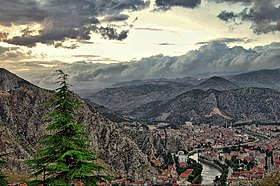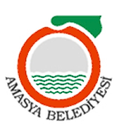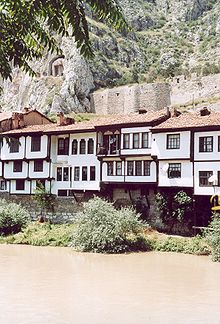Amasya
| Amasya | ||||
|
||||
 Look at Amasya |
||||
| Basic data | ||||
|---|---|---|---|---|
| Province (il) : | Amasya | |||
| Coordinates : | 40 ° 39 ' N , 35 ° 50' E | |||
| Height : | 411 m | |||
| Residents : | 113,932 (2018) | |||
| Telephone code : | (+90) 358 | |||
| Postal code : | 05 000 | |||
| License plate : | 05 | |||
| Structure and administration (as of 2019) | ||||
| Structure : | 37 Mahalle | |||
| Mayor : | Mehmet Sarı ( MHP ) | |||
| Website: | ||||
| Amasya County | ||||
| Residents : | 149,084 (2018) | |||
| Surface: | 1,889 km² | |||
| Population density : | 79 inhabitants per km² | |||
| Kaymakam : | Dr. Osman Varol | |||
| Website (Kaymakam): | ||||
Amasya ( ancient Greek Άμάσεια Amáseia , Latin Amasia ) is a city in Turkey with over 100,000 inhabitants and the capital of the Amasya province of the same name . At the same time, it also represents the central district (Merkez).
geography
Amasya is located in the hinterland of the Black Sea coast in the Pontic Mountains in the narrow valley of the Yeşilırmak river at 390 m above sea level. NN . The main part of the city extends on the east side of the river, on the west side there are only a few rows of houses at the foot of the steep castle hill. Five bridges connect both halves of the city.
The district is bounded internally by the districts Suluova (in the Mordwest), Göynücek (in the southeast) and Taşova in the east. Externally, the Ladik District of Samsun Province forms the border in the north and Turhal District of Tokat Province in the south . The district is the largest and also the most populous in the province. Its population density is slightly above the provincial average. In addition to the district town, the district also includes another city ( Belde ): At the end of 2018, Ziyaret had 3,901 inhabitants. The district still includes 100 villages ( Köy ) with an average of 313 inhabitants. Only two of the villages had over a thousand inhabitants: Ezinepazar (1,322) and Doğantepe (1,029).
Population development
The following table shows the comparative population level at the end of the year for the province, the central district and the city of Amasya and the respective share at the higher administrative level. The figures are based on the address-based population register (ADNKS) introduced in 2007.
| year | province | district | city | ||
|---|---|---|---|---|---|
| real | percent | real | percent | real | |
| 2018 | 337.508 | 44.17 | 149.084 | 76.42 | 113.932 |
| 2017 | 329,888 | 43.58 | 143,781 | 75.98 | 109,240 |
| 2016 | 326.351 | 42.82 | 139.732 | 74.88 | 104,629 |
| 2015 | 322.167 | 42.69 | 137,549 | 74.02 | 101,813 |
| 2014 | 321.913 | 42.23 | 135,950 | 72.77 | 98,935 |
| 2013 | 321,977 | 41.75 | 134,434 | 71.57 | 96.220 |
| 2012 | 322.283 | 41.31 | 133.133 | 69.01 | 91,874 |
| 2011 | 323.079 | 41.22 | 133,158 | 68.09 | 90,665 |
| 2010 | 334.786 | 42.90 | 143,635 | 69.55 | 99.905 |
| 2009 | 324.268 | 40.71 | 132.010 | 65.65 | 86,667 |
| 2008 | 323,675 | 39.76 | 128,703 | 63.87 | 82,200 |
| 2007 | 328,674 | 40.36 | 132,646 | 64.72 | 85.851 |
climate
| Amasya (409 m) | ||||||||||||||||||||||||||||||||||||||||||||||||
|---|---|---|---|---|---|---|---|---|---|---|---|---|---|---|---|---|---|---|---|---|---|---|---|---|---|---|---|---|---|---|---|---|---|---|---|---|---|---|---|---|---|---|---|---|---|---|---|---|
| Climate diagram | ||||||||||||||||||||||||||||||||||||||||||||||||
| ||||||||||||||||||||||||||||||||||||||||||||||||
|
Average monthly temperatures and rainfall for Amasya (409 m)
|
||||||||||||||||||||||||||||||||||||||||||||||||||||||||||||||||||||||||||||||||||||||||||||||||||||||||||||||||||||||||||||||||||||||||||||||||||||||
history
Today's Amasya is the successor to the ancient city of Amaseia. The history of the city goes back to the Hittite times, but it acquired its most important meaning in Hellenism : from approx. 300 BC. BC to 183 BC Amaseia was the capital of the kingdom of Pontos , after which the capital was moved to Sinope , which is located by the sea . In the 3rd Mithridatic War the city was destroyed in 70 BC. Conquered by the Romans and in 64 BC First in the Roman province of Bithynia et Pontus , since 25 BC. Assigned to the province of Galatia .
In late antiquity the city of Metropolis was the province of Diospontus or Helenopontus , in Byzantine times the seat of the Armeniacon theme . The Christian soldier Theodor von Euchaïta suffered a martyr's death here around 306 ; he is said to have cremated the Magna Mater temple in the city and was therefore tortured and burned. In 1076 the treacherous Norman mercenary Roussel Frangopolos was handed over from Emir Tutusch to the Byzantines under Alexios Komnenos. The Danischmenden -Emir Danischmend Ghazi conquered the city in 1075 and held it until it passed to the Seljuk ruler Kiliç Arslan II in the late 12th century . In 1386 the region around Amasya became part of the Ottoman Empire . In the Ottoman period, from 1396 onwards, Amasya reached its heyday as the residence of the princes of the ruling house and was known as the Baghdad of Rum or Oxford of the East , as important training centers were located here. Amasya lost its importance by the 19th century at the latest.
In the Turkish Liberation War , Mustafa Kemal called from here on June 22, 1919 for national resistance and called the Sivas Congress .
The Roman Catholic titular Archdiocese of Amasea goes back to the former diocese based in Amasya.
Attractions
Approx. The well-preserved castle lies 250 m above the city, some of which still has Hellenistic masonry, but in its current form is largely Byzantine. The town and castle were surrounded by a Hellenistic (?) Wall, some of which are still well preserved today. In the rock below the castle there are five chamber tombs with facades in an impressive location, which can be assigned to the first five kings of Pontus.
In addition to some mosques , madrasas and doorways from the 13th to 14th centuries The Sultan Bayezit Mosque ( Sultan Bayezit Camii ), commissioned in 1486 from the Ottoman period , and the unusual octagonal Kapı-Ağası- Medresesi ( Kapı Ağası Medresesi ) from 1488 are worth mentioning .
The city has been severely damaged by earthquakes several times, for example in 1734, 1825 and most recently in 1936, but has been restored again and again. The numerous late Ottoman houses along the river are particularly worth seeing.
The Archaeological Museum is also of interest . It shows finds from all epochs from the Bronze Age to the Ottoman era. The showpiece of the collection is the figurine by Amasya . From 1864 to 1924 there was the theological school called Anatolia College nearby , which had to move to the Kingdom of Greece after the Greco-Turkish War .
Town twinning
-
 Berat , Albania
Berat , Albania
-
 Brindisi , Italy
Brindisi , Italy
-
 Bursa , Turkey
Bursa , Turkey
-
 Lecce , Italy
Lecce , Italy
-
 Manisa , Turkey
Manisa , Turkey
-
 Nuuk , Greenland
Nuuk , Greenland
-
 Osh , Kyrgyzstan
Osh , Kyrgyzstan
- Prizren , Kosovo
-
 Sapporo , Japan
Sapporo , Japan
-
 Shamakhi , Azerbaijan
Shamakhi , Azerbaijan
-
 Solingen , Germany
Solingen , Germany
-
 Tulcea , Romania
Tulcea , Romania
Personalities
- Strabon (* around 63 BC; † around 23 AD), Greek historian and geographer, he described his hometown in his work Geographika (12, 3, 39)
- Theodor Tiro († approx. 306), saint of the Orthodox and Catholic churches
- Şerefeddin Sabuncuoğlu (around 1385 –1468), Ottoman surgeon
- Sultan Murad II (June 1404 - February 3, 1451 in Edirne )
- Amasyalı Beyazıd Paşa, Grand Vizier of the Ottoman Empire (1413–1421)
- Amirdovlat Amasiatsi, also Amirdovlat by Amaseia (* around 1420, † 1496), Armenian doctor and writer
- Sultan Selim I (October 10, 1465 - September 21, 1520 in Edirne)
- Adil Candemir (1917 - January 12, 1989), Turkish wrestler, trainer Hamit Kaplans
- Hamit Kaplan (born September 20, 1934 in nearby Hamamözü; † January 5, 1976), Turkish wrestler, two-time world champion
- Işın Yalçınkaya (* 1943), Turkish prehistorian and archaeologist
- Mahmut Demir (born January 21, 1970 in nearby Suluova), Turkish wrestler, Olympian, multiple European and world champion
- Sezer Akgül (born April 27, 1988), Turkish wrestler
- Ahmet Yıldırım (* 1974), football player and coach
- Uğur Dağdelen (1973-2015), football player
- Hakan Kutlu (* 1972), soccer player and coach
literature
- Albert Gabriel: Monuments turcs d'Anatolie . Vol. 2: Amasya-Tokat-Sivas . Paris 1934.
- Petra Kappert : The Ottoman princes and their Amasya residence in the 15th and 16th centuries . Istanbul, 1976. (Uitgaven van het Nederlands Historisch-Archaeologische Instituut te Istanbul 42) ISBN 90-6258-042-4
- Eckart Olshausen , Joseph Biller: Investigations into the historical geography of Pontos under the Mithradites . Wiesbaden, 1984. pp. 87-92.
- Clive Foss; David Winfield: Byzantine fortifications. An introduction . Pretoria, 1986. pp. 17-19 Figs. 54-62.
Individual evidence
- ↑ a b Nüfusu İl İlçe Mahalle Köy Nüfusu (Nufusune.com) , accessed on May 5, 2019
- ↑ Central Dissemination System / Merkezi Dağıtım Sistemi (MEDAS) of the TÜIK , accessed on May 5, 2019
- ↑ Otto Volk: Theodoros v. Euchaïta . In: Walter Kasper (Ed.): Lexicon for Theology and Church . 3. Edition. tape 9 . Herder, Freiburg im Breisgau 2000, Sp. 1411 .





